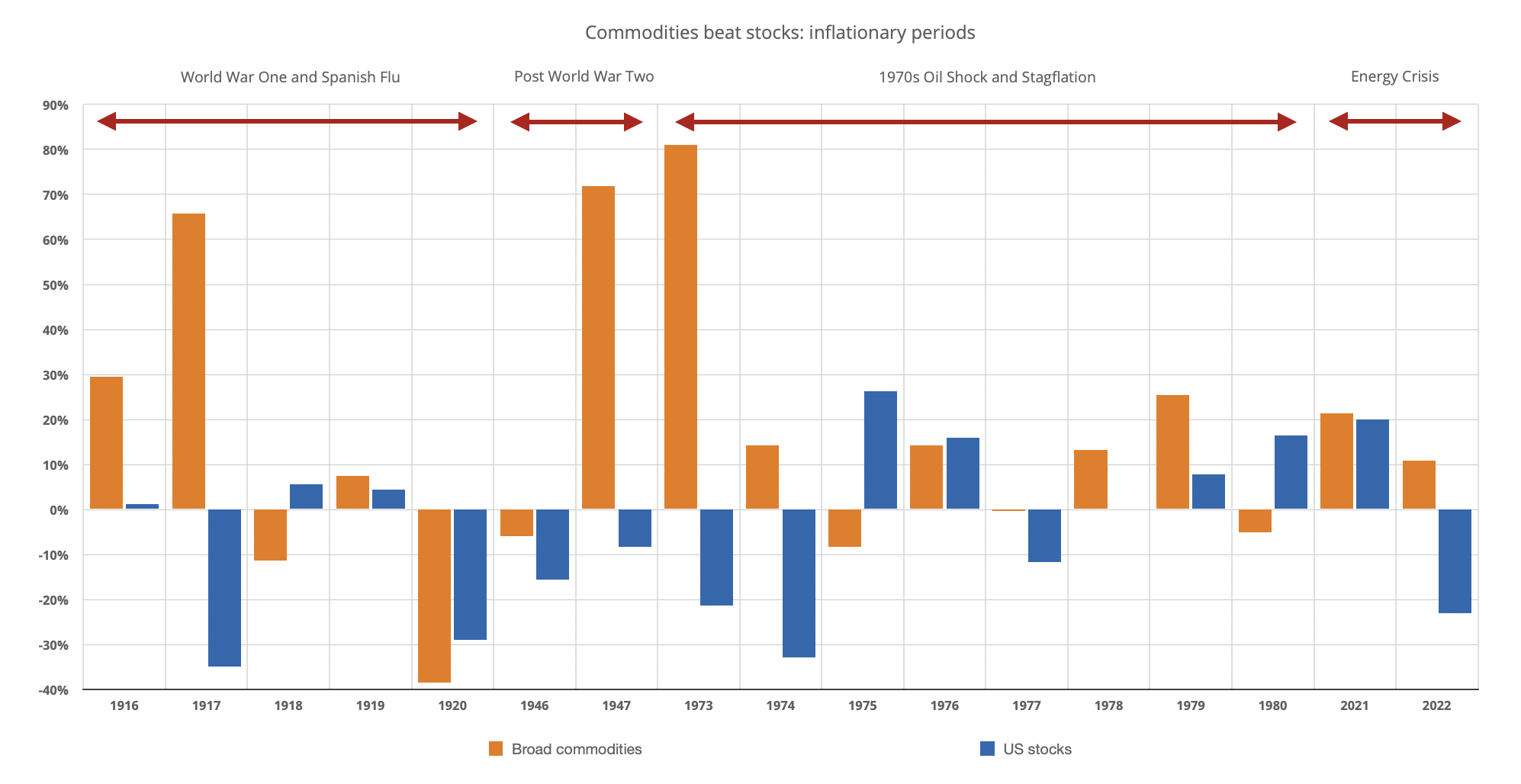
- Level: For advanced
- Reading duration: 15 minutes
What to learn in this article
justETF tip: This post discusses investing in ‘broad’ commodities. That’s shorthand for investing in the futures contracts of a diverse basket of raw materials including agricultural products (e.g. coffee and livestock), industrial metals, precious metals, and fuels such as oil and natural gas. This distinct asset class is investable using Commodity ETFs and we’ve written a short explainer on the topic if you’d like a quick intro.
Commodities research findings: the headlines
- Critically, the data shows that commodities deliver potent annualised investment returns over the long-term. A diversified investment in commodities comfortably outstrips bonds across the past 150 years and can even beat stocks over substantial time periods too.
- The record shows that commodities add diversification value to portfolios because they typically have a low correlation with equities and bonds.
- What’s more, the researchers show that commodities offer outsized protection against high and unexpected inflation relative to other major asset classes.
Commodities vs stocks vs bonds
This chart reveals why the long-run data for broad commodities makes us sit up and take notice:
Source: justETF research. Commodities futures index returns data from AQR. US stocks and bonds index returns data from JST Macrohistory. April 2023.
Hint: All returns quoted in this article are real total returns i.e. they are inflation-adjusted and include dividends and interest.
What you can read from the graph
- Of course, it’s hard to stop your eye from following the blue US stocks line. It represents a staggering long-term growth figure of 6.9% annualised.
- But the orange commodities line also shows a strong annualised return of 4.5%. That’s a good return in anyone’s language. It beats the long-term results of most non-US stock markets, for example.
- And commodities thrash the 2% long-term return of US government bonds as you can see in the chart above.
Commodities diversification potential
The case for commodities only builds when you examine its suitability as a portfolio diversifier and inflation hedge. The following table hints at the asset class’s potential.Asset class correlations: annual returns 1877-2022 (inflation adjusted)
| Commodities | US stocks | US Treasury bonds | US inflation | |
|---|---|---|---|---|
| Commodities | 1.00 | 0.15 | -0.20 | 0.15 |
| US stocks | 0.15 | 1.00 | 0.22 | -0.31 |
| US Treasury bonds | -0.20 | 0.22 | 1.00 | -0.53 |
| US inflation | 0.15 | -0.31 | -0.53 | 1.00 |
Source: justETF research. Commodities futures index returns data from AQR. US stocks and bonds index returns data from JST Macrohistory. April 2023.
The table shows:
- The dream diversifier has low correlations with both stocks and bonds. It also has a higher correlation with inflation than either of those conventional portfolio mainstays.
- Commodities negative correlation with bonds implies they’re liable to perform when US Treasuries suffer. This is an excellent result.
- Meanwhile, commodities' low but positive correlation with stocks suggests that the pair are complementary assets which can amplify or offset each other, depending on the prevailing conditions.
How to read this table
An investment correlations table shows how closely related the returns of pairs of assets are to each other. The relationships are understood by reference to the following framework:
- 1 = perfect correlation. An upward move in one asset is mirrored by an upward movement in the other. They fall in synchronicity too.
- 0 = no correlation. The returns of the two asset classes are unconnected. If one investment rises (or falls), anything could happen to the other.
- -1 = perfect negative correlation. When one asset class weakens, the other will strengthen and vice versa.
Commodities and inflation
The next chart shows how commodities and stocks performed during the four major inflationary outbreaks of the past 150 years.
Source: justETF research. Commodities futures index returns data from AQR. US stocks and bonds index returns data from JST Macrohistory. April 2023.
What you can read from the graph
- Commodities beat stocks in 12 out of 17 years when the inflation threat was high and escalating.
- The inflation protection offered by commodities was significantly better than stocks during these episodes, although you would still have to live with some negative years. Nothing is guaranteed.
What do excess returns mean?
Excess returns refer to investment performance above the return of a cash-like instrument such as treasury bills. The ‘excess return’ or ‘risk premium’ helps us gauge whether an investment’s growth potential is worth the risk versus the stability of cash in the bank.
When do commodities underperform?
Commodity returns are likely to deteriorate during recessions and disinflationary periods i.e. when inflation is weak and falling. Indeed, Dimson, Marsh, and Staunton identify the disinflation of the post-Global Financial Crisis period as a major contributory factor to the atrocious returns of commodities from 2008 to 2020. They think it unlikely that commodities are broken as an asset class, especially as similarly long slumps are a perfectly normal occurrence during the past century and a half for all of the major asset classes. The possibility of lost decades is an unavoidable truth of investing life that makes diversification across the asset classes so important. The lesson is: never pin all your hopes on a single source of return.The equal-weighted index problem
Sadly, as mentioned earlier, question marks remain and there’s no simple answer to this particular issue beyond compromise. At this point, the story takes a complicated twist. The researchers who’ve painstakingly unearthed the long-term returns of commodities have restored it in the form of equal-weighted indexes. In other words, their reconstructed indexes are composed of even proportions of every commodity type captured in their data. This is a standard academic convention but in the real world very few broad commodity future indexes are equally weighted. Fewer still are tracked by the available commodity ETFs. The major investable commodity indexes are weighted by world production quantities and / or liquidity. This matters because the historical returns from the reconstructed equal-weighted indexes are typically higher than the major investable indexes. The best long-run data we can get that corresponds to an available investable index comes from the research team of Bhardwaj, Janardanan, and Rouwenhorst of Summerhaven Investment Management and Yale. We can link their reconstruction of the Dow Jones Commodity Index to contemporary investable indexes. That enables us to calculate a 3.7% annualised return for broad commodities from 1934 to 2022. The historical equal weighted index we used in the charts above delivers a 5.4% annualised return during the same period. It appears that equal weighting confers a structural advantage that would be well worth having if it’s maintained in the future.The only choice is compromise
All told, the academic findings and our own calculations indicate that the ideal commodity ETF would track an equally weighted index. But currently, the only ETF in our database that does so is the Amundi Bloomberg Equal-weight Commodity ex-Agriculture UCITS ETF Acc. However, that ETF’s index excludes agricultural commodity futures. Now that’s not necessarily a flaw, but it doesn’t make the product the perfect investable fit for the research community’s work either - because their equal-weighted indexes invariably do include an agricultural component. Some sources suggest that risk-weighted (also known as volatility weighted) indexes bestow similar benefits to their equal-weighted counterparts. However, those ETF products are similarly thin on the ground. But do not despair!- Firstly, the properties that make broad commodities attractive - positive long-term returns, diversification, and inflation-hedging potential - remain intact when the research teams consider non-equal-weighted indexes.
- Secondly, do not let perfect be the enemy of good. 3.7% annualised is still an excellent historical return for a diversifying asset class. It’s much stronger than bonds or cash and the bulk of your portfolio’s growth potential should still be bound up in stocks anyway.
- Thirdly, most of the main commodity indexes do cap their weights to ensure no single futures type dominates, although this isn’t the same as equal weighting.
Commodities asset allocation
If you’re intrigued by the potential of commodities then the next obvious question is what’s the correct asset allocation? Inevitably, there’s no right answer as it depends on unique and personal factors such as your objectives, risk tolerance, and the composition of your particular portfolio. Moreover, no-one can determine the optimal blend of assets in advance as the future dispersion of returns cannot be accurately forecast. Yet the consensus built on the back of the latest research does allow us to form some reasonable conclusions.- For instance, commodities should only be viewed as a potential supplement to stocks and bonds. They are not a replacement for either.
- Nor are commodities a vital portfolio building block in the way that stocks and bonds are. You should feel no compunction about leaving this extra asset class complexity on the sidelines for now if you remain unsure or unconvinced.
- But if you are excited about the potential, then it may be best to carve out your commodities allocation from both the growth and defensive side of your portfolio.
- The lower expected returns of commodities versus stocks implies lowering your portfolio’s overall return if the allocation is taken solely from your growth allocation.
- However, commodities' tendency to decline during recessions means you could expose yourself to deeper drawdowns during an economic slump if the entire allocation is taken from bonds.
- For example, a minimum asset allocation of 5% makes sense because anything less will barely move the needle.
- Bear in mind that 20%+ allocations for strategic diversifiers can be tough to maintain when the asset slumps.
- Inevitably, the broader cultural conversation will invite you to compare your atypical allocation to the market portfolio. That’s fine when the comparison works in your favour but psychologically wearing when the investing fates conspire against you.
- The middle ground, of course, is a 10% allocation. That’s enough to make a noticeable difference to your outcomes without being too painful should commodity returns not bear fruit in the years ahead.















